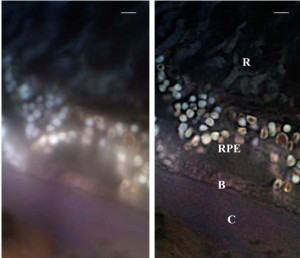SMI Spatially Modulated Illumination - Structured Illumination
SMI (spatially modulated illumination) microscopy is a light optical process of the so-called point spread function Engineering. These are processes that modify the point spread function (PSF) of a microscope in a suitable manner to either increase the optical resolution, to maximize the precision of distance measurements of fluorescent objects that are small relative to the wavelength of the illuminating light, or to extract other structural parameters in the nanometer range.more
References
- R. Heintzmann, C. Cremer (1999) Lateral modulated excitation microscopy: Improvement of resolution by using a diffraction grating. Proc. SPIE 3568: 185–196
- US patent 7,342,717, filed 10th july 1997: Christoph Cremer, Michael
Hausmann, Joachim Bradl, Bernhard Schneider Wave field microscope with detection point spread
function - Reymann, J; Baddeley, D; Gunkel, M; Lemmer, P; Stadter, W; Jegou, T; Rippe, K; Cremer, C et al. (2008). "High-precision structural analysis of subnuclear complexes in fixed and live cells via spatially modulated illumination (SMI) microscopy". Chromosome research : an international journal on the molecular, supramolecular and evolutionary aspects of chromosome biology 16 (3): 367–82. doi:10.1007/s1 MID 18461478.
- Best G, Amberger R, Baddeley D, Ach T, Dithmar S, Heintzmann R and Cremer C (2011). Structured illumination microscopy of autofluorescent aggregations in human tissue. Micron, 42, 330–335
SMI (spatially modulated illumination) microscopy is a light optical process of the so-called point spread function Engineering. These are processes that modify the point spread function (PSF) of a microscope in a suitable manner to either increase the optical resolution, to maximize the precision of distance measurements of fluorescent objects that are small relative to the wavelength of the illuminating light, or to extract other structural parameters in the nanometer range.
The Vertico microscope achieves this in the following manner: The illumination intensity within the object range is not uniform, unlike conventional wide field fluorescence microscopes, but is spatially modulated in a precise manner by the use of one or two opposing interfering laser beams along the axis. The object is moved in high-precision steps through the wave field, or the wave field itself is moved relative to the object by phase shift. This results in an improved axial size and distance resolution.
SMI can be combined with other super resolution technologies, for instance with 3D LIMON or LSI-TIRF as a total internal reflection interferometer with laterally structured illumination. This SMI technique allowed to acquire light-optical images of autofluorophore distributions in the sections from human eye tissue with previously unmatched optical resolution. Use of three different excitation wavelengths (488, 568 and 647 nm), enables to gather spectral information about the autofluorescence signal. This has been used for of human eye tissue affected by macular degeneration AMD.
References
- R. Heintzmann, C. Cremer (1999) Lateral modulated excitation microscopy: Improvement of resolution by using a diffraction grating. Proc. SPIE 3568: 185–196
- US patent 7,342,717, filed 10th july 1997: Christoph Cremer, Michael Hausmann, Joachim Bradl,
Bernhard Schneider Wave field microscope with detection point spread
function - Reymann, J; Baddeley, D; Gunkel, M; Lemmer, P; Stadter, W; Jegou, T; Rippe, K; Cremer, C et al. (2008). "High-precision structural analysis of subnuclear complexes in fixed and live cells via spatially modulated illumination (SMI) microscopy". Chromosome research : an international journal on the molecular, supramolecular and evolutionary aspects of chromosome biology 16 (3): 367–82. doi:10.1007/s1 MID 18461478.
- Best G, Amberger R, Baddeley D, Ach T, Dithmar S, Heintzmann R and Cremer C (2011). Structured illumination microscopy of autofluorescent aggregations in human tissue. Micron, 42, 330–335



